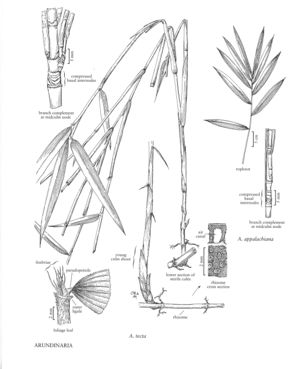Difference between revisions of "Arundinaria appalachiana"
imported>Volume Importer |
imported>Volume Importer |
||
| Line 39: | Line 39: | ||
|publication year= | |publication year= | ||
|special status= | |special status= | ||
| − | |source xml=https:// | + | |source xml=https://bitbucket.org/aafc-mbb/fna-data-curation/src/2e0870ddd59836b60bcf96646a41e87ea5a5943a/coarse_grained_fna_xml/V24/V24_12.xml |
|subfamily=Poaceae subfam. Bambusoideae | |subfamily=Poaceae subfam. Bambusoideae | ||
|tribe=Poaceae tribe Bambuseae | |tribe=Poaceae tribe Bambuseae | ||
Revision as of 21:49, 5 November 2020
Rhizomes normally horizontal for only a short distance before turning up to form a culm, sometimes hollow-centered, air canals sometimes present. Culms 0.5-1 (1.8) m tall, 0.2-0.6 cm thick; internodes terete. Culm leaves persistent to tardily deciduous; sheaths 5.5-11 cm; fimbriae 1-4.6 mm; blades 0.8-1.4 cm. Topknots of 6-12 leaves; blades 9-22.5 cm long, 1.4-2.8 cm wide, linear, linear-lanceolate, or ovate-lanceolate. Primary branches usually shorter than 35 cm, erect, terete, with 2-5 compressed basal internodes, basal nodes not developing secondary branches. Foliage leaves: abaxial ligules glabrous or ciliate, fimbriate or lacerate; blades 5-20 cm long, 0.8-2 cm wide, chartaceous, deciduous, bases rounded, abaxial surfaces pilose or glabrous, weakly cross veined, adaxial surfaces pilose. Spikelets 3-5.5 cm, usually somewhat reddish purple, with 5-8 florets. 2n = unknown.
Distribution
Ala., Ga., N.C., S.C., Tenn.
Discussion
Arundinaria appalachiana grows on moist to dry slopes and in seeps. It is restricted to the southern Appalachians and upper piedmont.
Selected References
None.
